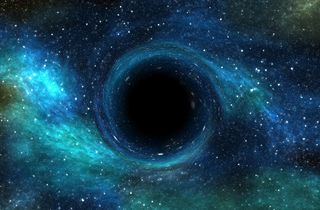Why is space a vacuum?

Space is an almost perfect vacuum, full of cosmic voids. And in short, gravity is to blame. But to really understand the vacuum of our universe, we have to take a moment to understand what a vacuum really is — and what it's not.
So, what is a vacuum, and why isn't space a true vacuum?
First, forget the vacuum cleaner as an analogy to the vacuum of space, Jackie Faherty, a senior scientist in the Department of Astrophysics at the American Museum of Natural History in New York City, told Live Science. The household cleaning machine effectively fills itself with dirt and dust sucked out of your carpet. (That is, the vacuum cleaner uses differential pressure to create suction. Suction cleaner might be a better name than vacuum cleaner). But the vacuum of space is the opposite. By definition, a vacuum is devoid of matter. Space is almost an absolute vacuum, not because of suction but because it's nearly empty.
Related: What would happen if you shot a gun in space?
That emptiness results in an extremely low pressure. And while it's impossible to emulate the emptiness of space on Earth, scientists can create extremely low pressure environments called partial vacuums.
Even with the vacuum cleaner analogy out, "understanding the concept of the vacuum is almost foreign because it's so contradictory to how we exist, Faherty said. Our experience as humans is completely confined to a very dense, crowded and dynamic fraction of the universe. So, it can be hard for us to really understand nothingness or emptiness, she said. But in reality, what's normal for us on Earth, is actually rare in the context of the universe, the vast majority of which is nearly empty.
Gravity is king
On average, space would still be pretty empty even if we didn’t have gravity. "There's just not a lot of stuff relative to the volume of the universe in which you put that stuff," according Caltech theoretical astrophysicist Cameron Hummels. The average density of the universe, according to NASA, is 5.9 protons (a positively charged subatomic particle) per cubic meter. But then gravity amplifies the emptiness in certain regions of the universe by causing the matter in the universe to congregate.
Basically, any two objects with mass will be attracted to each other. That's gravity. Put another way, "matter likes to be around other matter," Faherty said. In space, gravity draws nearby objects closer together. Together their collective mass increases, and more mass means they can generate a stronger gravitational pull with which to draw even more matter into their cosmic clump. Mass increases, then gravitational pull, then mass. "It's a runaway effect," Hummel said.
As these gravitational hot spots pull in nearby matter, the space between them is evacuated, creating what's known as a cosmic void, Hummel said. But the universe didn't start that way. After the Big Bang, the matter in the universe was dispersed more uniformly, "almost like a fog," he said. But over billions of years, gravity has gathered that matter into asteroids, planets, stars, solar systems and galaxies; and leaving between them the voids of interplanetary, interstellar and intergalactic space.
But even the vacuum of space is not truly pure. Between galaxies, there's less than one atom in every cubic meter, meaning intergalactic space isn't completely empty. It has far less matter, however, than any vacuum humans could simulate in a lab on Earth.
Meanwhile, "the universe keeps expanding," Faherty said, assuring that the cosmos will remain mostly vacant. "It sounds so lonely," she said.
Originally published on Live Science.
No comments:
Post a Comment